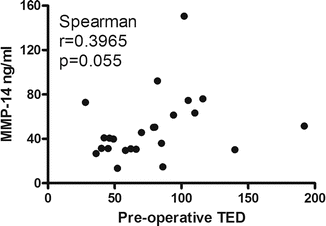Fig. 7.1
Measurement of total extension deficit. Patients (n = 25) underwent fasciectomy for Dupuytren Disease. Total extension deficit was measured with a goniometer, with deficit from affected digits added together. Measurement was taken preoperatively, at an intermediate stage (up to 12 weeks after surgery), and then postoperatively at approximately 1 year
7.3.2 Correlation of Gene Expression with TED
Initially, the expression of MMP1, MMP13 and MMP14 was measured at the mRNA level in Dupuytren Disease tissue taken at fasciectomy. Gene expression was correlated with TED taken preoperatively, immediately postoperatively (intermediate) and then at one year postoperatively (as in Sect. 7.3.1). Compared to our previous study (Johnston et al. 2008), there was little correlation in this cohort, with a statistically significant correlation between MMP1 expression and the change between preoperative and one year postoperative TED (Fig. 7.2a). A correlation was also measured between MMP14 expression and the change between intermediate and one year postoperative TED, approaching statistical significance (Fig. 7.2b).


Fig. 7.2
Correlation between gene expression in nodule tissue and total extension deficit. Expression of matrix metalloproteinase (MMP) gene expression ((a) MMP1 and (b) MMP14) was measured by qRT-PCR in tissue (nodule) taken at fasciectomy (n = 14) and correlated with change in total extension deficit
7.3.3 Correlation of Circulating MMPs with TED
The level of MMP-1, MMP-13 and MMP-14 was measured in plasma taken preoperatively and correlated with measurements of TED. Whilst there was no correlation with postoperative progression of TED (i.e. disease recurrence), a correlation was seen between the circulating level of MMP-14 and preoperative TED (Fig. 7.3) which approached statistical significance.


Fig. 7.3
Correlation between measurement of circulating MMP-14 and total extension deficit. Matrix metalloproteinase-14 (MMP-14) was measured in the plasma of patients with Dupuytren Disease (n = 25) in advance of fasciectomy and correlated with total extension deficit
7.3.4 Correlation of Gene Expression with TED
RNA from ten Dupuytren nodules was subjected to whole genome array to measure total gene expression. These were then subjected to correlation analyses. Interestingly, the expression of a number of genes was correlated with either preoperative TED (e.g. ASPN, asporin, Fig. 7.4a) or postoperative TED (e.g. fucosyltransferase 1, FUT1, Fig. 7.4b).


Fig. 7.4
Correlation between gene expression by microarray and total extension deficit. Gene expression was measured in a subset of Dupuytren patients (n = 10) by microarray. Gene expression was correlated with total extension deficit. (a) ASPN, asporin; (b) FUT1, fucosyltransferase 1
7.4 Discussion
There are a number of genes/proteins associated with DD, coming from genetic studies, e.g. Dolmans et al. (2011); microarray analyses, e.g. Shih et al. (2012b); or targeted approaches, e.g. Raykha et al. (2013). Any of these proteins which are extracellular have the potential to be biomarkers of disease.
We sought to explore the utility of collagen-degrading proteases (MMP-1, MMP-13 and MMP-14) as circulating biomarkers of postsurgical recurrence of Dupuytren Disease after fasciectomy. Twenty-five patients undergoing fasciectomy were recruited, taking a blood sample preoperatively. Tissue was then collected at surgery for gene expression analyses.
Measurement of TED showed the expected decrease immediately postoperatively, with patients then progressing either to a further decrease in TED or an increase. This increase in TED between the immediately postoperative stage and then at one year was deemed to be recurrence of disease.
Whilst our earlier studies had shown correlation between the tissue expression of MMP1, MMP13 and MMP14 and disease recurrence defined in this way, there was only poor correlation in the current study. This may simply reflect variation in patient cohorts.
Similarly there was no correlation between disease recurrence and the circulating level of any of the MMPs. However, there was a correlation between circulating MMP-14 and preoperative TED which adds to evidence from ourselves (Johnston et al. 2007, 2008; Wilkinson et al. 2012) and others (e.g. Shih et al. 2012a) that MMP-14 has a role in the mechanisms underlying Dupuytren Disease.
Stay updated, free articles. Join our Telegram channel

Full access? Get Clinical Tree







